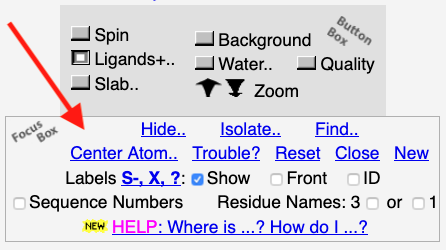
- #Jmol first glance archive#
- #Jmol first glance code#
- #Jmol first glance series#
- #Jmol first glance free#
"Early" endosomes can pick up new proteins and other constituents as well as shed them as they move and mature through the cell. This eventually pinches off to form an endosomal vesicle which is surrounded by a protein called clathrin.
#Jmol first glance series#
This triggers a series of events which leads to the invagination of the cell membrane at that point. Initially, the LDL or virus binds to a receptor on the surface of the cell. Small molecules can generally pass through these membrane pores while large one are selected based on their tendency to form transient intermolecular attractive forces with the pore proteins.Įndocytosis. Very large particles (for example, LDL or low-density lipoproteins or viruses) can enter a cell through a process called endocytosis. Porins are found in mitochondrial membranes while nucleoporins are found in the nuclear membrane. Pores. Some membranes (nuclear, mitochondria) assemble proteins (such as porins) to form large, but regulated pores. Flow of ions through the channel proceeds in a thermodynamically favored direction, which depends on their concentration and voltage gradients across the membrane. Some are permanently open (nongated) while others are gated open or closed depending on the presence of ligands that bind the protein channel and the local environment of the protein in the membrane. Ion channels. These membrane proteins allow the flow of ions across membranes. Transporters, carrier proteins, and permeases. These membrane proteins move specific ligand molecules across a membrane, typically down a concentration gradient.

In fact, membrane transport proteins are involved in the movement of both nonpolar and polar molecules. Given the amphiphilic nature of the bilayer (polar head group exterior, nonpolar interior), you would expect that polar molecule like glucose would have difficulty in moving across the membrane. Molecules can also move up a concentration gradient in a process called "active transport". Molecules can move into the cell by passive diffusion across the membrane but usually, their movement is "facilitated" by a membrane receptor. The imported molecules must pass through the cell membrane and in some cases through additional membranes if they need to reside inside membrane-bound organelles. Import/Export. Many of the chemical constituents of the cell arise not from direct synthesis but from import of both small and large molecules. In contrast to DNA, RNA, and protein polymers, the length and sequence of a polysaccharide polymer is not driven by a template but rather by the enzymes that catalyze the polymerization.
#Jmol first glance code#
The genetic code has the master plan that determines the sequence of all cellular proteins, which then catalyze almost all other activities in the cell, including catalysis, motility, architectural structure, etc. Of course, the DNA blueprint must be read out (transcribed) by protein enzymes which themselves were encoded by the DNA. Also at Design. The design for a cell mostly resides in the blueprint for the cell, the genetic code, which is comprised of the DNA in the cell nucleus and a small amount in the mitochondria. Used with permission from Liliana Torres.
#Jmol first glance free#
sequence, structure, and pathway) information.ĬhemSpider is a free chemical structure database owned by the Royal Society of Chemistry.\( \newcommand\): A Eukaryotic Cell. chemical, pharmacological and pharmaceutical) data with comprehensive drug target (i.e. The DrugBank database is a unique bioinformatics and cheminformatics resource that combines detailed drug (i.e. It is targeted at students learning Organic Chemistry in the early years of College or University programmes. Is a free site designed to promote active learning of Chemistry. Is a simple tool for macromolecular visualization. Orientations of Proteins in Membranes (OPM) database "provides spatial arrangements of membrane proteins with respect to the hydrocarbon core of the lipid bilayer." Structural View of Biology is a portion of the PDB, focusing on the biological function of the molecules.
#Jmol first glance archive#
The Protein Data Bank (PDB ) is the single worldwide archive of structural data of biological macromolecules, now containing more than 100,000 structures. Please get in touch with any suggestions for candidate compounds (or categories) Web references and useful websites More molecules to be added in the near future

Salbutamol, terbutamine, adrenaline and triamcinolone Non Steroidal Anti Inflammatory Drugs (NSAIDs) Non-nucleoside reverse transcriptase inhibitor ( NNRTI)

Plant sterols and stanols and their esters Please let me know if these are (or are not) working on your system!Īlpha-linolenic acid gamma-linolenic acid


 0 kommentar(er)
0 kommentar(er)
